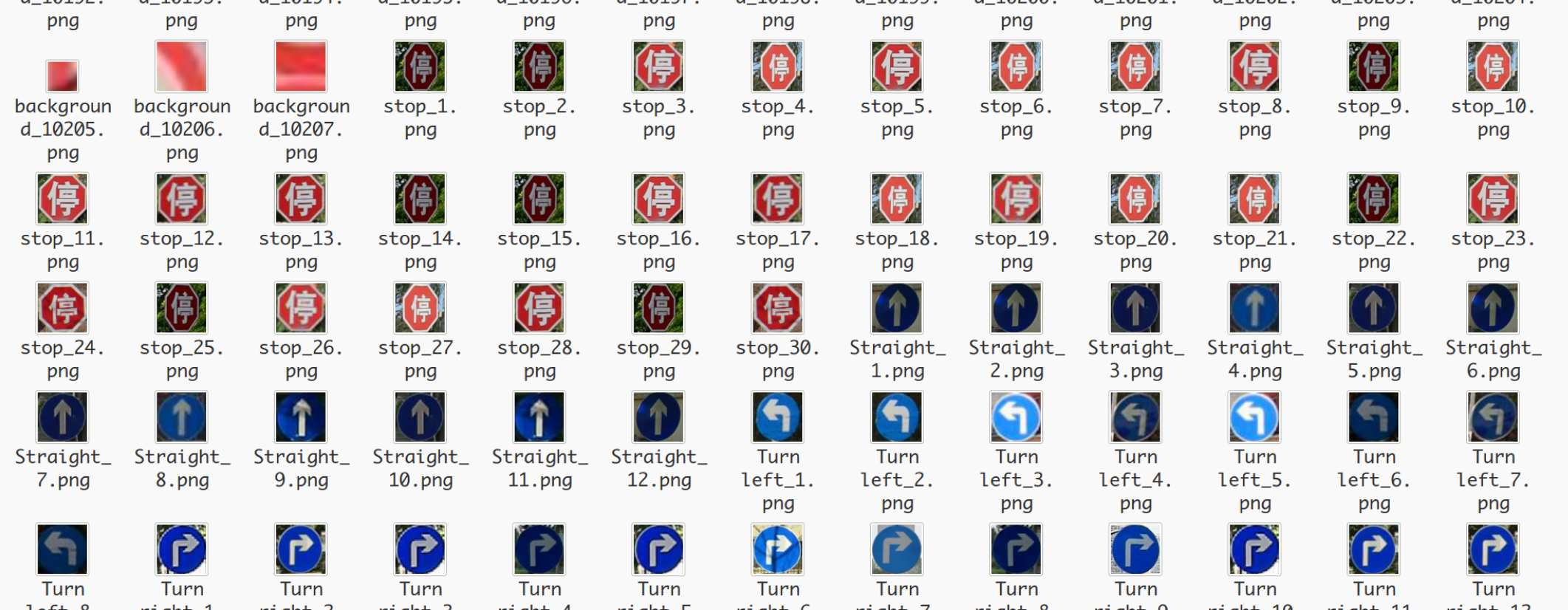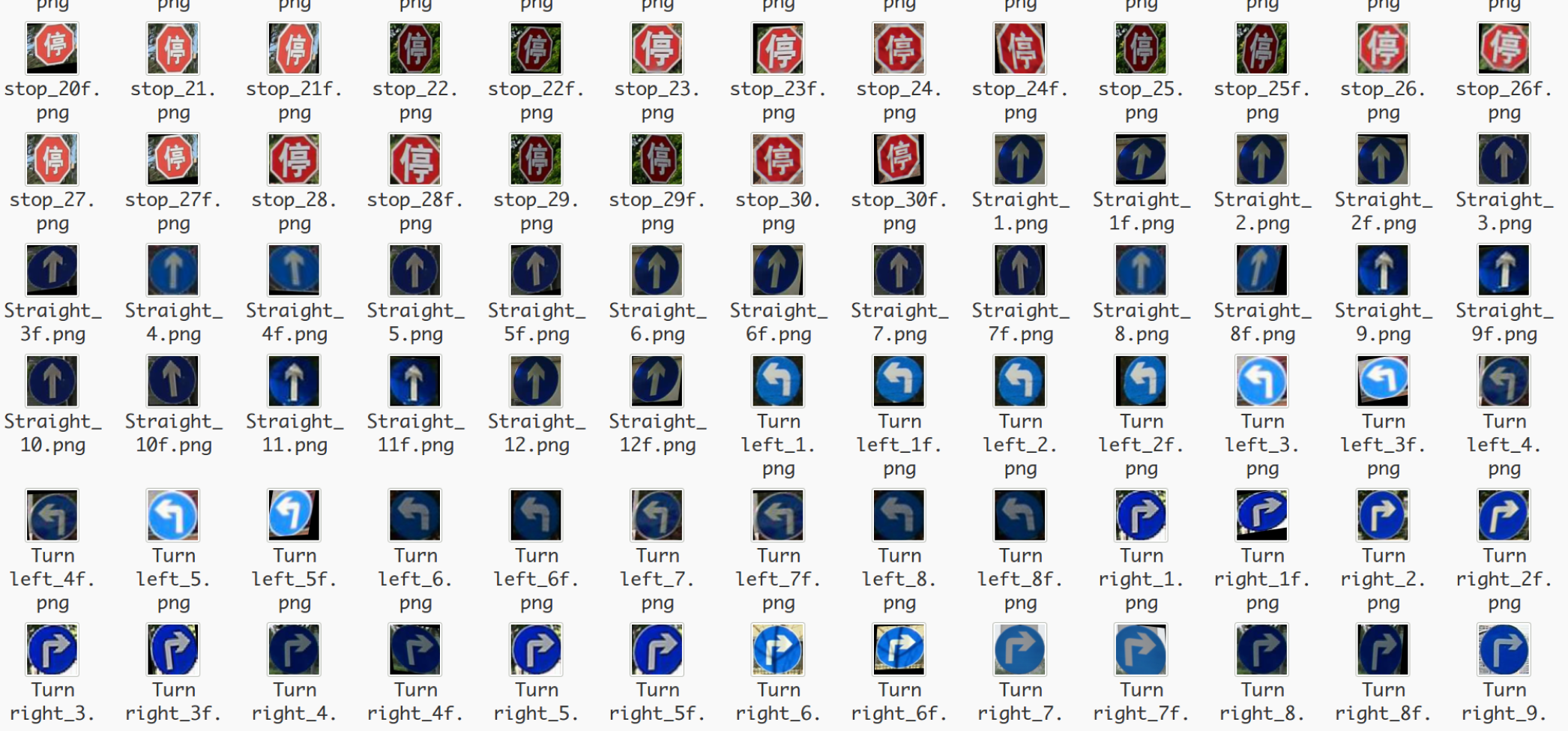由于该项目是针对中小学生竞赛并且是第一次举行,所以识别的目标交通标志仅仅只有直行、右转、左转和停车让行。
整体流程如下:
- 数据集收集(包括训练集和测试集的分类)
- 图像预处理
- 图像标注
- 根据标注分割得到目标图像
- HOG特征提取
- 训练得到模型
- 将模型带入识别算法进行识别
我的数据目录树。其中test_images/train_images是收集得到原始数据集。realTest/realTrain是预处理后的图像。dataTest/dataTrain是经过分类处理得到的图像,HogTest/HogTrain是通过XML标注后裁剪得到的图像。HogTest_affine/HogTrain_affine是经过仿射变换处理扩充的训练集和测试集。imgTest_hog.txt/imgTrain_hog.txt是测试集和训练集的Hog特征

一、图像处理
由于得到的数据集图像大小不一(如下),我们首先从中心区域裁剪并调整正方形图像的大小,然后将处理后的图像保存到realTrain和realTest里面。

图片名称对应关系如下:
img_label = { "000":"Speed_limit_5", "001":"Speed_limit_15", "002":"Speed_limit_30", "003":"Speed_limit_40", "004":"Speed_limit_50", "005":"Speed_limit_60", "006":"Speed_limit_70", "007":"Speed_limit_80", "008":"No straight or right turn", "009":"No straight or left turn", "010":"No straight", "011":"No left turn", "012":"Do not turn left and right", "013":"No right turn", "014":"No Overhead", "015":"No U-turn", "016":"No Motor vehicle", "017":"No whistle", "018":"Unrestricted speed_40", "019":"Unrestricted speed_50", "020":"Straight or turn right", "021":"Straight", "022":"Turn left", "023":"Turn left or turn right", "024":"Turn right", "025":"Drive on the left side of the road", "026":"Drive on the right side of the road", "027":"Driving around the island", "028":"Motor vehicle driving", "029":"Whistle", "030":"Non-motorized", "031":"U-turn", "032":"Left-right detour", "033":"traffic light", "034":"Drive cautiously", "035":"Caution Pedestrians", "036":"Attention non-motor vehicle", "037":"Mind the children", "038":"Sharp turn to the right", "039":"Sharp turn to the left", "040":"Downhill steep slope", "041":"Uphill steep slope", "042":"Go slow", "044":"Right T-shaped cross", "043":"Left T-shaped cross", "045":"village", "046":"Reverse detour", "047":"Railway crossing-1", "048":"construction", "049":"Continuous detour", "050":"Railway crossing-2", "051":"Accident-prone road section", "052":"stop", "053":"No passing", "054":"No Parking", "055":"No entry", "056":"Deceleration and concession", "057":"Stop For Check" }
def center_crop(img_array, crop_size=-1, resize=-1, write_path=None): ##从中心区域裁剪并调整正方形图像的大小。 rows = img_array.shape[0] cols = img_array.shape[1] if crop_size==-1 or crop_size>max(rows,cols): crop_size = min(rows, cols) row_s = max(int((rows-crop_size)/2), 0) row_e = min(row_s+crop_size, rows) col_s = max(int((cols-crop_size)/2), 0) col_e = min(col_s+crop_size, cols) img_crop = img_array[row_s:row_e,col_s:col_e,] if resize>0: img_crop = cv2.resize(img_crop, (resize, resize)) if write_path is not None: cv2.imwrite(write_path, img_crop) return img_crop
然后根据得到的realTrain和realTest自动生成带有<size><width><height><depth><filename>的xml文件
def write_img_to_xml(imgfile, xmlfile): img = cv2.imread(imgfile) img_folder, img_name = os.path.split(imgfile) img_height, img_width, img_depth = img.shape doc = Document() annotation = doc.createElement("annotation") doc.appendChild(annotation) folder = doc.createElement("folder") folder.appendChild(doc.createTextNode(img_folder)) annotation.appendChild(folder) filename = doc.createElement("filename") filename.appendChild(doc.createTextNode(img_name)) annotation.appendChild(filename) size = doc.createElement("size") annotation.appendChild(size) width = doc.createElement("width") width.appendChild(doc.createTextNode(str(img_width))) size.appendChild(width) height = doc.createElement("height") height.appendChild(doc.createTextNode(str(img_height))) size.appendChild(height) depth = doc.createElement("depth") depth.appendChild(doc.createTextNode(str(img_depth))) size.appendChild(depth) with open(xmlfile, "w") as f: doc.writexml(f, indent=" ", addindent=" ", newl=" ", encoding="utf-8")
<annotation> <folder>/home/xiao5/Desktop/Test2/data/realTest/PNGImages</folder> <filename>000_1_0001_1_j.png</filename> <size> <width>640</width> <height>640</height> <depth>3</depth> </size> </annotation>
然后对realTrain和realTest的图片进行标注,向默认XML添加新的信息(矩形信息)。
<annotation> <folder>PNGImages</folder> <filename>021_1_0001_1_j.png</filename> <path> C:Usersxiao5Desktop ealTestPNGImages�21_1_0001_1_j.png </path> <source> <database>Unknown</database> </source> <size> <width>640</width> <height>640</height> <depth>3</depth> </size> <segmented>0</segmented> <object> <name>Straight</name> <pose>Unspecified</pose> <truncated>0</truncated> <difficult>0</difficult> <bndbox> <xmin>13</xmin> <ymin>22</ymin> <xmax>573</xmax> <ymax>580</ymax> </bndbox> </object> </annotation>
处理完后利用我们添加的矩形将图片裁剪下来并且重命名进行分类。主要思路是:解析XML文档,根据<name>标签进行分类,如果是直行、右转、左转、停止,那么就把它从原图中裁剪下来并重命名,如果没有<object>那么就认为是负样本,其中在处理负样本的时候,我进行了颜色识别,把一张负样本图片根据颜色(红色、蓝色)裁剪成几张负样本,这样做的好处是:我们在进行交通标志的识别时,也是使用的颜色识别来选取到交通标志,我们从负样本中分割出来的相近颜色样本有利于负样本的训练,提高模型精度。
def produce_proposals(xml_dir, write_dir, square=False, min_size=30): ##返回proposal_num对象 proposal_num = {} for cls_name in classes_name: proposal_num[cls_name] = 0 index = 0 for xml_file in os.listdir(xml_dir): img_path, labels = parse_xml(os.path.join(xml_dir,xml_file)) img = cv2.imread(img_path) ##如果图片中没有出现定义的那几种交通标志就把它当成负样本 if len(labels) == 0: neg_proposal_num = produce_neg_proposals(img_path, write_dir, min_size, square, proposal_num["background"]) proposal_num["background"] = neg_proposal_num else: proposal_num = produce_pos_proposals(img_path, write_dir, labels, min_size, square=True, proposal_num=proposal_num) if index%100 == 0: print ("total xml file number = ", len(os.listdir(xml_dir)), "current xml file number = ", index) print ("proposal num = ", proposal_num) index += 1 return proposal_num

为了提高模型的精确度,还对目标图片(四类图片)进行仿射变换来扩充训练集。
def affine(img, delta_pix): rows, cols, _ = img.shape pts1 = np.float32([[0,0], [rows,0], [0, cols]]) pts2 = pts1 + delta_pix M = cv2.getAffineTransform(pts1, pts2) res = cv2.warpAffine(img, M, (rows, cols)) return res def affine_dir(img_dir, write_dir, max_delta_pix): img_names = os.listdir(img_dir) img_names = [img_name for img_name in img_names if img_name.split(".")[-1]=="png"] for index, img_name in enumerate(img_names): img = cv2.imread(os.path.join(img_dir,img_name)) save_name = os.path.join(write_dir, img_name.split(".")[0]+"f.png") delta_pix = np.float32(np.random.randint(-max_delta_pix,max_delta_pix+1,[3,2])) img_a = affine(img, delta_pix) cv2.imwrite(save_name, img_a)

二、HOG特征提取
处理好图片后分别对训练集和测试集进行特征提取得到imgTest_HOG.txt和imgTrain_HOG.txt
def hog_feature(img_array, resize=(64,64)): ##提取HOG特征 img = cv2.cvtColor(img_array, cv2.COLOR_BGR2GRAY) img = cv2.resize(img, resize) bins = 9 cell_size = (8, 8) cpb = (2, 2) norm = "L2" features = ft.hog(img, orientations=bins, pixels_per_cell=cell_size, cells_per_block=cpb, block_norm=norm, transform_sqrt=True) return features def extra_hog_features_dir(img_dir, write_txt, resize=(64,64)): ##提取目录中所有图像HOG特征 img_names = os.listdir(img_dir) img_names = [os.path.join(img_dir, img_name) for img_name in img_names] if os.path.exists(write_txt): os.remove(write_txt) with open(write_txt, "a") as f: index = 0 for img_name in img_names: img_array = cv2.imread(img_name) features = hog_feature(img_array, resize) label_name = img_name.split("/")[-1].split("_")[0] label_num = img_label[label_name] row_data = img_name + " " + str(label_num) + " " for element in features: row_data = row_data + str(round(element,3)) + " " row_data = row_data + " " f.write(row_data) if index%100 == 0: print ("total image number = ", len(img_names), "current image number = ", index) index += 1
三、模型训练
利用得到的HOG特征进行训练模型得到svm_model.pkl
def load_hog_data(hog_txt): img_names = [] labels = [] hog_features = [] with open(hog_txt, "r") as f: data = f.readlines() for row_data in data: row_data = row_data.rstrip() img_path, label, hog_str = row_data.split(" ") img_name = img_path.split("/")[-1] hog_feature = hog_str.split(" ") hog_feature = [float(hog) for hog in hog_feature] #print "hog feature length = ", len(hog_feature) img_names.append(img_name) labels.append(label) hog_features.append(hog_feature) return img_names, np.array(labels), np.array(hog_features) def svm_train(hog_features, labels, save_path="./svm_model.pkl"): clf = SVC(C=10, tol=1e-3, probability = True) clf.fit(hog_features, labels) joblib.dump(clf, save_path) print ("finished.")
四、交通标志识别及实验测试
交通标志识别的流程:颜色识别得到阈值范围内的二值图、然后进行轮廓识别、剔除多余矩阵。
def preprocess_img(imgBGR): ##将图像由RGB模型转化成HSV模型 imgHSV = cv2.cvtColor(imgBGR, cv2.COLOR_BGR2HSV) Bmin = np.array([110, 43, 46]) Bmax = np.array([124, 255, 255]) ##使用inrange(HSV,lower,upper)设置阈值去除背景颜色 img_Bbin = cv2.inRange(imgHSV,Bmin, Bmax) Rmin2 = np.array([165, 43, 46]) Rmax2 = np.array([180, 255, 255]) img_Rbin = cv2.inRange(imgHSV,Rmin2, Rmax2) img_bin = np.maximum(img_Bbin, img_Rbin) return img_bin ''' 提取轮廓,返回轮廓矩形框 ''' def contour_detect(img_bin, min_area=0, max_area=-1, wh_ratio=2.0): rects = [] ##检测轮廓,其中cv2.RETR_EXTERNAL只检测外轮廓,cv2.CHAIN_APPROX_NONE 存储所有的边界点 ##findContours返回三个值:第一个值返回img,第二个值返回轮廓信息,第三个返回相应轮廓的关系 contours, hierarchy= cv2.findContours(img_bin.copy(), cv2.RETR_EXTERNAL, cv2.CHAIN_APPROX_NONE) if len(contours) == 0: return rects max_area = img_bin.shape[0]*img_bin.shape[1] if max_area<0 else max_area for contour in contours: area = cv2.contourArea(contour) if area >= min_area and area <= max_area: x, y, w, h = cv2.boundingRect(contour) if 1.0*w/h < wh_ratio and 1.0*h/w < wh_ratio: rects.append([x,y,w,h]) return rects
然后加载模型进行测验
if __name__ == "__main__": cap = cv2.VideoCapture(0) cv2.namedWindow('camera') cv2.resizeWindow("camera",640,480) cols = int(cap.get(cv2.CAP_PROP_FRAME_WIDTH)) rows = int(cap.get(cv2.CAP_PROP_FRAME_HEIGHT)) clf = joblib.load("/home/xiao5/Desktop/Test2/svm_model.pkl") i=0 while (1): i+=1 ret, img = cap.read() img_bin = preprocess_img(img) min_area = img_bin.shape[0]*img.shape[1]/(25*25) rects = contour_detect(img_bin, min_area=min_area) if rects: Max_X=0 Max_Y=0 Max_W=0 Max_H=0 for r in rects: if r[2]*r[3]>=Max_W*Max_H: Max_X,Max_Y,Max_W,Max_H=r proposal = img[Max_Y:(Max_Y+Max_H),Max_X:(Max_X+Max_W)]##用Numpy数组对图像像素进行访问时,应该先写图像高度所对应的坐标(y,row),再写图像宽度对应的坐标(x,col)。 cv2.rectangle(img,(Max_X,Max_Y), (Max_X+Max_W,Max_Y+Max_H), (0,255,0), 2) cv2.imshow("proposal", proposal) cls_prop = hog_extra_and_svm_class(proposal, clf) cls_prop = np.round(cls_prop, 2) cls_num = np.argmax(cls_prop)##找到最大相似度的索引 if cls_names[cls_num] is not "background": print(cls_names[cls_num]) else: print("N/A") cv2.imshow('camera',img) cv2.waitKey(40) cv2.destroyAllWindows() cap.release()
